
Yoghurt parfait, Cafe Saudade
[ <<previous | index | next >> ]
19:19, Incomum Wine Bar
We are having a relaxing dinner of snacks and glasses of wine at the wine bar attached to Incomum restaurant where we had dinner last night. It's been a busy day of walking and sightseeing all over the hills above Sintra.
We slept in a bit, not getting up until 07:30. For breakfast we headed over to the Cafe Saudade, which was operated by the same people as the Chalet, and was up the street and around the corner. This was the venue for breakfast if the option of a breakfast with the room was taken, adding 9€ to the price. But we decided to simply go there and order off the menu and see if we could have breakfast cheaper. While there we saw some other people get the 9€ breakfast, which included bread rolls, croissants, cheese, cold meats, yoghurt with fruit, a boiled egg, juice, and coffee or tea.
 Yoghurt parfait, Cafe Saudade |
Instead of that we ordered a "yoghurt parfait" each, which was yoghurt, fruit, and muesli topped with honey. It was good. And then we ordered some extras. I got a travesseiros, which is a type of pastry from the Sintra region. It was a crisp flaky pastry roll topped with sugar, and stuffed with almond cream. It was nice, but very sugary. M. wanted the apple and berry scone which was listed in the menu, but the waitress said it was either apple or berry, not both. M. asked for berry. But then the waitress returned and said they were out of berry scones, so M. asked for apple. And the waitress went away and returned again, saying there were no apples scones either! So then she asked what the toasted "bolo do caco" was, and the waitress said it was a type of bread typical of he region. So M. ordered that, and it actually came this time. It turned out to be a large round bread a bit like an English muffin squashed flat, both in shape and texture. It came toasted and buttered and the small bite M. let me try was really good. Our total was only about 12€ rather than the 18€ for the fixed breakfast, so we'll probably try the same thing tomorrow.
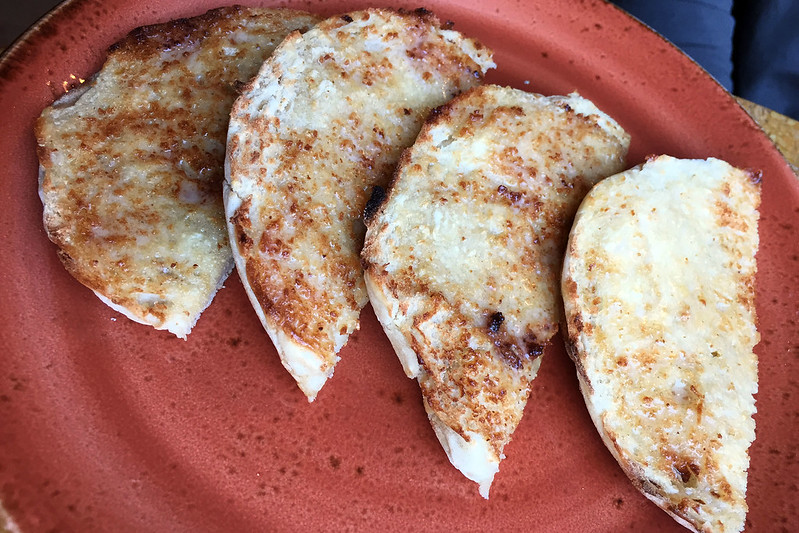 Bolo do caco, Cafe Saudade |
After eating we returned to our room to use the bathroom and prepare for a busy day out. We asked the woman at reception how much we should expect to pay for a tuk-tuk ride to the top of the hill and the entrance to Pena Palace. She said 5€ per person, so that gave us a bargaining point to negotiate with the drivers who lined up to offer rides to tourists in the town. She also said to be careful and tell the drivers to slow down because they didn't always drive safely, especially coming downhill. So armed, we walked into town near the train station and found a few tuk-tuk drivers looking for fares. M. decided she wanted to ask a female driver because she suspected they wouldn't be as reckless. We saw one, but she stated baldly that the fare was 10€ per person and didn't seem inclined to negotiate. As we walked away, a man raced up to us and offered us fares of 7.50€ a person, saying the going rate was 10€ and we wouldn't find a better deal. He also said he'd stop anywhere we wanted so we could take photos. I thought we might be able to bargain him down a bit, but M. declined to make an offer (earlier she'd told me to leave the bargaining to her) and we walked away. We decided to check the buses to the top and found a ticket office near the bus stop by the station. I'd been under the impression from our guesthouse receptionist yesterday that the bus cost 6.90€ for a return ticket and that single trips were not available. But the woman in the ticket office asked if I wanted one way, and I said yes, and the price was only 3.90€ each. So that was considerably cheaper than we had any hope of getting on a tuk-tuk.
 Bicycle propped outside a shop in Sintra |
Buses were queued up at the stop and we got on the front one, which was empty as one had left as we walked up. It waited about 10 minutes and filled to about half full before departing. It took a circuitous route several kilometres up and down the hill, which I tracked on my GPS app, until it returned to Sintra, on a different street, further up the hillside on the other side of the station. It looks like it had to make a journey of several kilometres just to get to this street which we could have walked to in about 5 minutes! Here there were more passengers waiting and they boarded the bus, and then another group of four people ran up to the bus, waving at the driver. He closed the door and I thought was going to drive off with them standing right outside, but he opened the door again and let them on. And then it took them five minutes of discussion to figure out what tickets they wanted and organise to pay the driver for them before they continued into the bus and we could finally get underway again.
The bus now proceeded up a very steep, narrow, and winding road though the densely forested hillside. The views glimpsed through the trees were spectacular. The bus stopped at the entrance to the Moorish Castle, perched on a rocky crag high above Sintra and visible from the town. This is a ruined wall now, and the guesthouse receptionist said the only reason to come here is for the views, as there's nowhere to inspect inside, and we could miss it if pressed for time. The next stop was the entrance for the Palace of Pena, which is also perched atop another peak, but hidden from view from Sintra further back in the hills.
 Pena Palace, viewed from halfway up the hill from the entrance gate to the park |
The Palace is an amazing riot of colourful towers and turrets in yellow, blue, and burnt orange, and we could glimpse it still some way above us at the entrance station. The grounds are extensive and form the Park of Pena. A small bus waited to transport people who couldn't manage the steep uphill walk to the palace, but we set off bravely and slogged our way up the hill, reaching the palace about 10 minutes later. There were many people here milling about, taking photos, and trying to figure out where to go next.
 Pena Palace entrance |
There was a queue to get inside the palace building, but it was longish and fully exposed to the sun which was starting to get hot. We feigned ignorance and blundered around a bit, bumping into the queue area closer to the door. Nobody said anything, so we ended up with a decent place and a few minutes later were in a shaded area near the door. There was a bit of a delay as the woman guarding the door held us up, saying that the tour group right in front of us was blocking the way and it would be better for us if we let them pass one a bit. She chatted to us while we waited, asking where we were from and saying she wanted to visit Australia one day. After a few minutes she scanned our tickets again and let us in.
 Pena Palace interior room |
The interior was good, roughly on a par with the palace in Belém, though with some older areas and decorations, as this was an older building, although with additions and renovations up until 1910. At one point a door led out to the Queen's terrace, a sunny exterior area high up the side of the palace and commanding an amazing view over the land outside. One room was the Stag Room, a round room with a large domed roof, decorated with artificial stag heads. It had been intended as a dining room for knights, but was now being used to display some of the collection of stained glass that the king had been passionate about collecting.
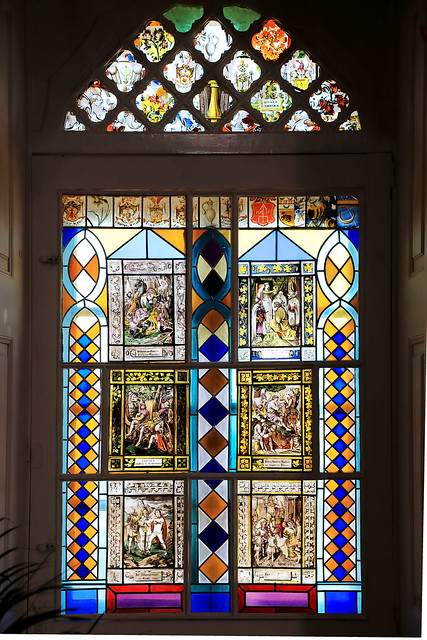 Pena Palace stained glass |
The last room was the kitchen, another large space thought not as large as in the Sintra Palace, full of copper pots and also a collection of copper jelly moulds, including one in the shape of a large pig.
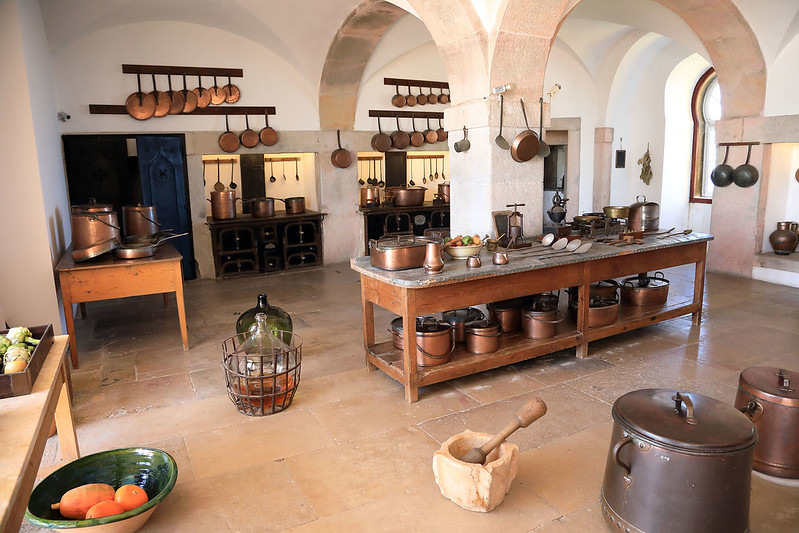 Pena Palace kitchen |
The exit disgorged us into the rooftop terrace cafeteria area, where tables clustered under large shade umbrellas. I managed to grab us a shady table while M. investigated the cafeteria for suitable snacks. She was inside for a while, but emerged empty handed and looked at the small counter outside where a bored looking woman was selling a few items like empanadas in a pie warmer. M. said that selection looked better than what was inside, which was mainly bags of chips and stuff like that. So I went over and had a look and bought a tomato and oregano pastry that M. said she wanted, plus a beef empanada and a small spinach pie. The empanada was decent, nicely hot. Then after offering M. some of the spinach pie I bit into it, and it was cold! I expressed surprise and M. said that her pastry was cold too, in fact as if it had just been taken out of the fridge. This was odd as all three pastries had been sitting in the same pie warmer. Presumably the cold ones had just been put in and not had time to warm up yet. Anyway, we finished this snack and then set out again.
 Pena Palace exterior, showing the cafeteria seating under umbrellas |
M. wanted to go downstairs to the gift shop and toilets, while I decided to check out the terrace area where a sign pointed. She said she'd wait for me downstairs. As it happened, the terrace area led to a tunnel under the interior rooms above and out to another terrace on the far side of the palace, and from there there were stairs leading up to a chapel, and then around the ramparts of the palace wall, and even further and then into towers and so on. I took a good fifteen minutes or so exploring all these areas before heading down to meet M. in the gift shop.
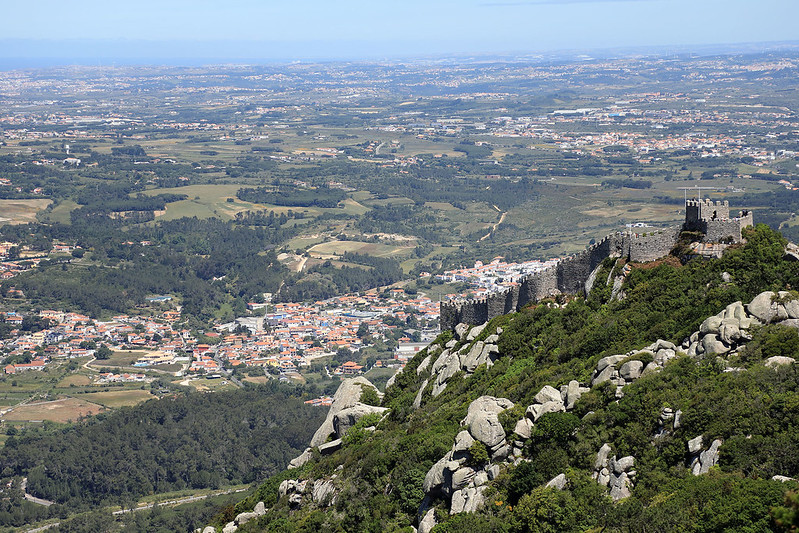 View over Sintra and the Moorish Castle from Pena Palace |
Leaving the palace itself, we took a walk to explore the grounds a bit. The park is enormous, and includes a long walk to the highest peak of the Sintra hills, where a replica of a medieval stone cross stands. The original was removed only a few years ago after being damaged by lightning, and was now installed by the path we'd walked up to the palace, so we got a good look at it. We could easily have spent a whole day or more exploring the park, but we wanted to head back down to Sintra to see other sights in the afternoon, so we chose a path that led towards the lower entrance gate.
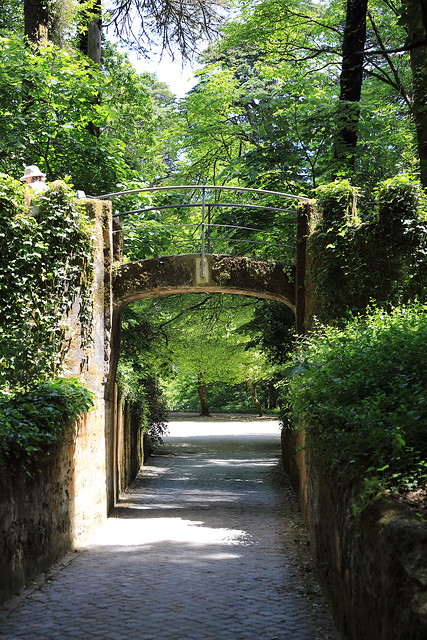 Heading down the path through the palace grounds |
The path led downhill, past a few outbuildings, including an octagonal one named the Water Wheel for no apparent reason, then a glass greenhouse amidst the camellia garden, and finally a Moorish domed building with Arabic script around the outside, over a fountain. The gardens were lovely, although not yet in full flower. There were some rhododendrons flowering early, but the camellias hadn't yet come out. The hillside was quite steep, with the paths winding back and forth as they led down the hill towards a small valley at the bottom, where a series of small lakes cascaded along the valley, populated by ducks, swans, and geese.
 Valley of the Lakes |
At the bottom of the lakes was the entrance gate. Here we saw the woman in a bridal dress and sandshoes who we'd seen down in Sintra while looking for a ride up the hill to the palace. She'd been walking around with a possible groom and a photographer, but now up here there was no sign of either of them. Although this was an entrance gate the park and the palace, I can see why everyone goes to the other entrance gate, since it's a long way further up the steep hill, and walking up to the palace from here would be a real chore.
 Valley of the Lakes |
We left the park of Pena Palace and crossed the road to find a small car park with a sign indicating this was the beginning of the hiking trail to Vila Sassetti and Sintra. When we'd asked the woman at reception yesterday about the possibility of walking up to Pena Palace, she'd mentioned this trail but warned that it was a long walk and very steep. Heading down now we discovered just how arduous it would have been to come up the other direction. Our path actually began heading uphill towards the Moorish Castle, but reached an intersection where it continued up to the castle, with a side trail leading down a series of steps towards Vila Sassetti.
The trail now led us downhill rapidly in a succession of sloping paths and steep steps, with a couple of brief uphill sections. It led through thick forest and the scenery was beautiful. We passed several walkers heading up the hill, breathing heavily and wondering how much further to go, but we were taking it easy in the downhill direction. We passed the Cliff of Amizade, a sheer wall of granite rising up the face of the hill above us, and apparently a haven for rock climbers, as we passed a handful of them, and we could see bolts attached to the rock face above us.
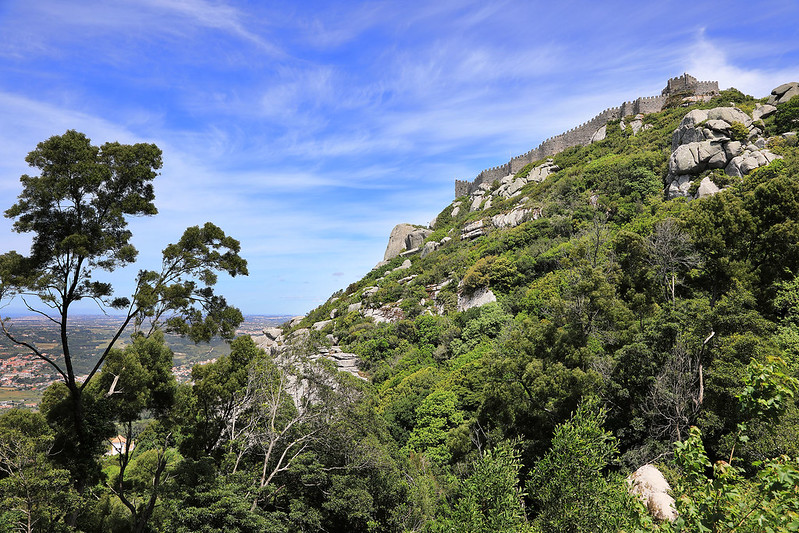 Moorish Castle above, with the Cliff of Amizade on the left side |
Below the cliff the path plunged back into forest, leading downhill steeply again. Signs posted on the trail said we would soon reach Vila Sassetti, but we were still a long way from Sintra, and I expected the Vila to be close to the village according to maps I'd seen. The puzzle was solved when we reached a stone wall and a gate leading through it, with a sign indicating this was Vila Sassetti. So it was the property we had reached, but there was still a long walk down the hill inside the property to the house. Here the untamed forest took on a noticeably different character, still somewhat wild, but with human touches that made it feel a bit more like a garden than a forest. There were fewer trees and more flowering plants.
 Outside the wall of the grounds of Vila Sassetti |
The path switchbacked down the hill, leading towards the main house if Vila Sassetti. A small outbuilding had been converted to toilets for visitors, but the main house was not open and could only be admired from the outside, from where it presented a picturesque view with three storeys of stone decorated and roofed with red clay tiles, leading up to a large circular tower at the top. There were good views from the path on the steep hillside approaching from above. From here the path continued to lead down the hill, underneath trellises holding passionfruit vines in flower. A cascade of water flowed in rocky pools and waterfalls down the hillside, underneath the path which crossed it in the middle of each switchback. Further along was the gardener's house, a smaller and less picturesque affair, which had been fitted out with a small cafe for visitors.
 House of Vila Sassetti |
Eventually we reached the very bottom of the property and the gate leading out to one of the streets of Sintra. From here it was just a short walk down a flight of steps to the heart of the old town. M. led us to the Lord Byron Cafe, which we'd liked the look of yesterday. It's a tiny cafe nestled in the Y junction of two steep streets, one leading up and one down. The interior is dim and decorated with various pictures and quotes from Byron. Despite this, the old man who served us had only rudimentary English, and I struggled to make him understand that M. wanted a toasted sandwich with just cheese, no ham and no tomatoes. Fortunately it came as requested, as did my chicken empada, a tiny pie full of spiced chopped chicken, which came served cold rather than hot. M. also got a cappuccino, which came with a bit of whipped cream and chocolate sprinkles on top. M.'s toasted cheese was in fact two whole sandwiches plus a small basket of potato chips.
 Grilled cheese sandwich at Lord Byron Cafe |
After this filling second lunch we launched off to tackle the second big site of the day, Quinta da Regaleira. M. asked me what it was, but I hadn't done any research other than to know that it was the site of a famous large well. I guessed it might be a monastery or something. It's only ten minutes walk outside Sintra, and when we arrived and bought tickets and picked up an informative map guide, I read that it was the property of a man who simply built eccentric developments on it, a bit like a Portuguese Gaudí.
 Palace of Quinta da Regaleira |
There was a palace-like house, a chapel, a tennis court walled with crenellated walls, several towers, ornate walls, grottoes, fountains, and so on scattered about the property, which like everything in Sintra was on a steep hillside. We began by walking up towards the top of the hill, to see the major attraction, the Well of Initiation.
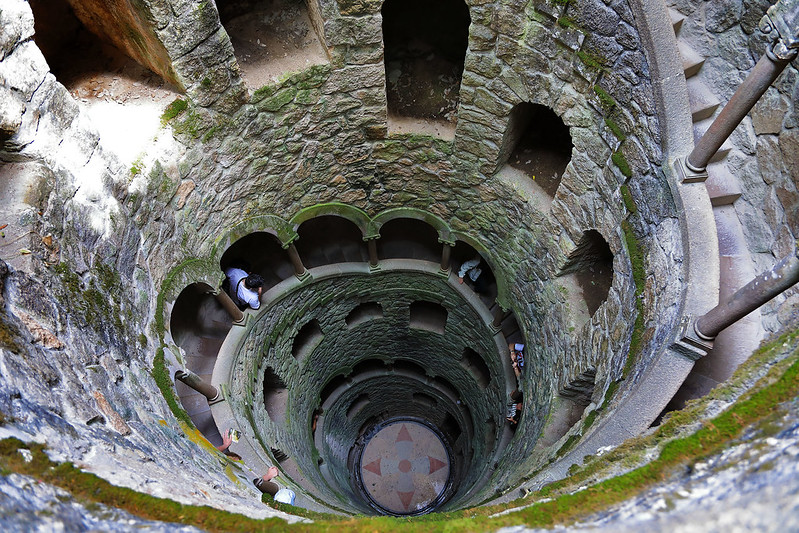 Well of Initiation |
This is a deep, wide well that is the subject of millions of photographs because of its beautiful spiral staircase and archways descending into the earth, draped with dangling ferns. You could walk down about five storeys or so to the bottom, from where a cave-like tunnel led through the rock to a labyrinth of connected passages that ran between several of the sites on the property. I emerged behind a waterfall some distance away, but had to retrace my steps and emerge back up the well because M. hadn't wanted to climb down the claustrophobic steps.
 Well of Initiation |
From the Well we walked a bit further up to check out a grotto marked on the map. The navigation was confusing, with a maze of narrow walkways up and down steps connecting a series of wider, flatter paths that switchbacked lazily up the hill. We got lost and ended up against the top wall of the property, further than we'd intended to come.
 Observation Tower |
Working our way back down the hill we passed the Incomplete Well (another well similar to the first but not as deep and with a partially built additional storey on top), the tennis court, the House of the Ibis (where an exterior wall had a fountain decorated with an ibis mosaic), a large duck pond covered in duckweed, and the waterfall where I'd emerged earlier. We could see people behind the water, but there was no way out for them there. They had to continue through the cave, emerging at a place at water level where the only way out was via a series of pillar-like stepping stones rising through the deep water to a level just a centimetre or so above the surface of the water. People gingerly made their way across them, and I'm sure some people must lose their balance and fall in occasionally.
 Cave exit stepping stones |
From here we made our way across the slope to the chapel, a small building of white stone with a pointy spire covered in filigree. We couldn't go inside, but the door was open to allow a look into the small area inside, which was lavishly decorated. Nearby was the palace, which we now entered to look through the interior. Although called a palace it was really not a very large house, with standard sort of rooms inside. In one room a piano player was giving a recital, and several people were sitting on chairs to watch and listen. After seeing half a dozen or so rooms we emerged from the exit. From here it was a short walk to the exit gate of the property, where we emerged back into the streets of Sintra, having seen pretty much everything on the site.
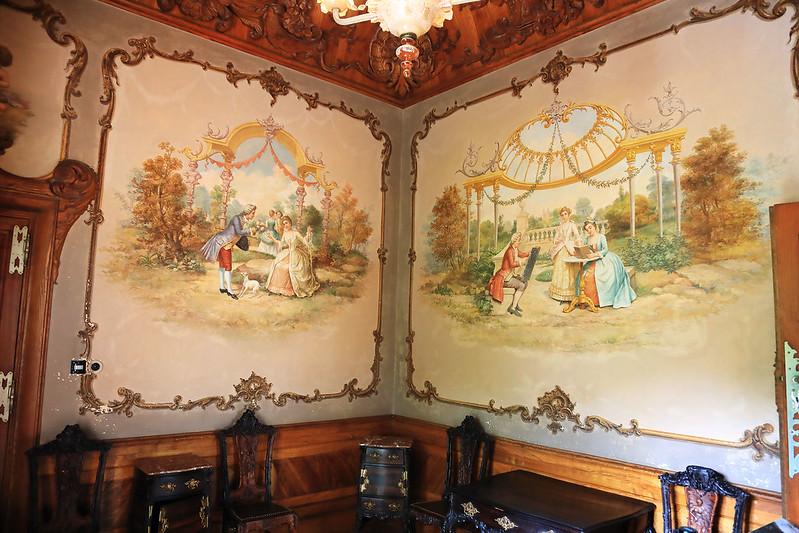 Quinta da Regaleira palace interior |
By the time we walked back to Chalet Saudade, it was 17:30. Our plan was to rest for a bit and then go to the Incomum wine bar attached to Incomum restaurant where we'd eaten last night. Their menu was more bar snacks, but there was enough to make up a dinner. We ordered a cheese board, which came with a round of soft, mild sheep's cheese, chunks of a very hard and sharp and tangy sheep's cheese served in a bowl with herbs and oil, and long thin wedges of a cow's milk cheese which was about midway between a mature cheddar and parmesan. The cheeses came with a small bunch of very large red globe grapes and a spicy tomato chutney which the waiter said went well with all the cheeses. We asked him about the extensive wine list, and M. chose a rounded fruity red from the Sintra region, while I chose a Vinho Verde white to complement the serve of anchovies in tomato sauce that I ordered to go with the cheese. We also got a basket of bread, which had a thin crispy bread, some of the same dense sticky bread we'd had at the restaurant last night, and sliced chunks of a light white bread.
 Cheese board and anchovies at Incomum Wine Bar |
We ate leisurely. After a while, M. asked the waiter about the differences between tawny port, which is the sort we'd been used to, and ruby port, which was what we had at Casa do Alentejo. He explained that tawny is matured for several years in oak barrels, and this takes away the red colour, making the port more brownish, and also the fruit flavours, and imparts more woody, toasty flavours, whereas the ruby is matured in oak only a short while, so retains more of the fruity characteristics. Then he brought us two glasses and poured samples of ruby and tawny port for us to taste. The difference was clear in the colour, aroma, and taste of each. We concluded that whereas M. had never liked tawny port, she enjoyed the fruitier flavours of the ruby.
To make the dinner a bit more filling, M. ordered a bowl of the vegetable soup of the day, which was spinach, and another basket of bread to help me finish off the remaining cheese. The soup was delicious, and I had a bit with some of the bread too. I also ordered another glass of wine, trying a hearty red from the Douro region, a Syrah with the label Labrador, which actually had a Labrador dog on the bottle. It was rich and spicy, similar to an Australian shiraz, and the waiter said this was unusual for a Portuguese Syrah, as they usually come out a bit lighter and less spicy because of the soils.
 Egg and almond cake at Incomum Wine Bar |
They had a few desserts in display on the counter and I asked what they were, before settling on a slice of a dense looking tart that the waiter said was primarily eggs and almonds. I asked if it had any other flavours like lemon or orange, but he said no, just eggs and almonds. It was thick and heavy and rich, like a very dense custard, with slivered almonds throughout, not almond meal as I'd been expecting. It was very rich, but good.
We paid up and headed back to Chalet Saudade for our last night in Sintra. On the way in we asked the man at reception if the train strike was on or not. He checked online and said it had been cancelled, so that was good. As long as it stays cancelled until we leave Portugal!
[ <<previous | index | next >> ]